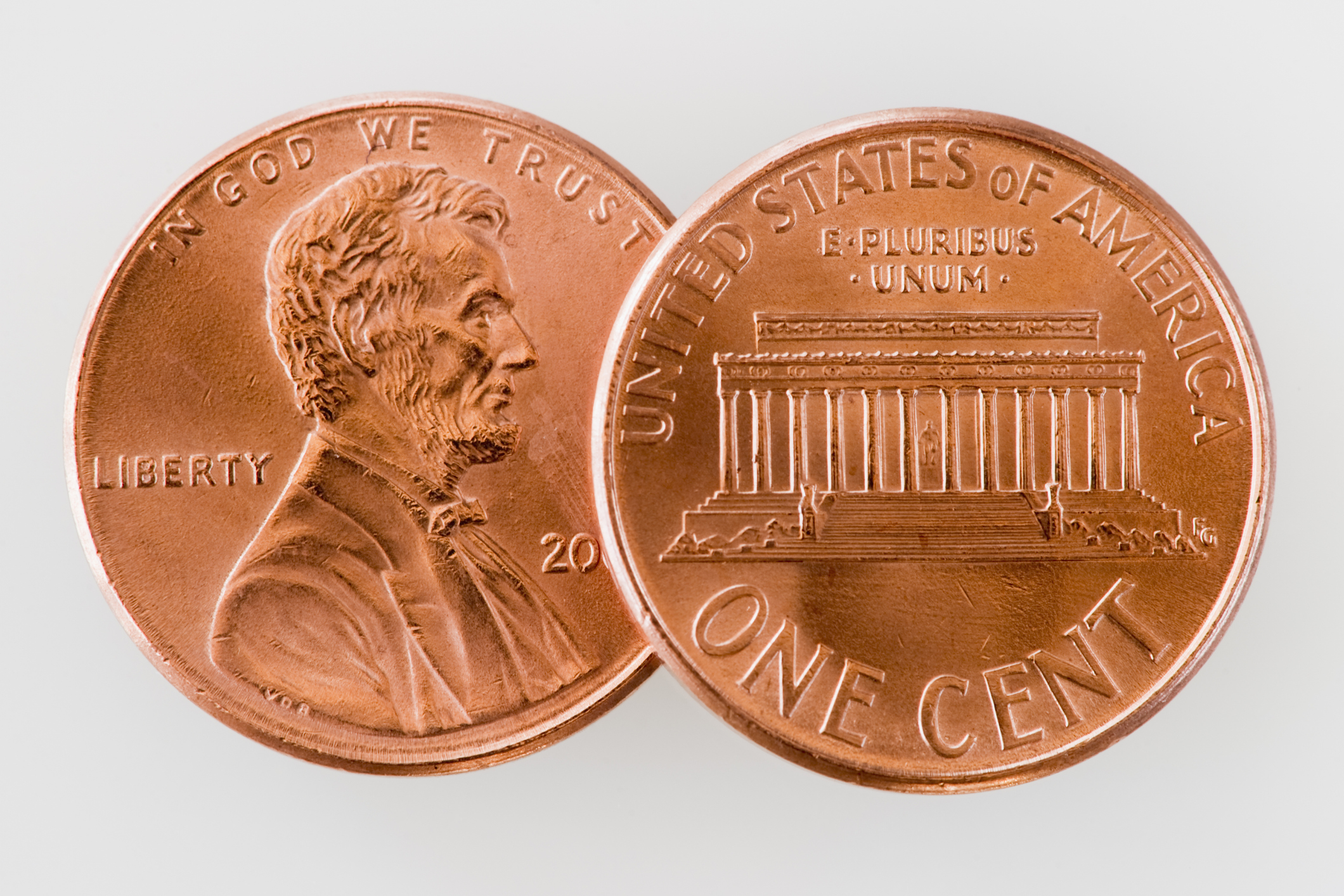Farewell to the Penny: US Treasury Ends Production of One Cent Coin
After more than 200 years, the U.S. bids adieu to the penny, citing high production costs and shifting economic practices.

After nearly two centuries, the U.S. government is ending the production of the penny. The U.S. penny discontinuation means that, in time, these coins that you grew up with will no longer be in circulation.
For many Americans, the penny is more than just pocket change. It’s a nostalgic reminder of childhood piggy banks, exact-change and “a penny saved is a penny earned.” While often overlooked in daily life, the penny has been a constant in wallets, registers and charity jars for generations.
This change stands to impact everything from retail sales prices to coin collectors. And, with the penny taken out of production, a bit of U.S. history will be lost.
From just $107.88 $24.99 for Kiplinger Personal Finance
Become a smarter, better informed investor. Subscribe from just $107.88 $24.99, plus get up to 4 Special Issues

Sign up for Kiplinger’s Free Newsletters
Profit and prosper with the best of expert advice on investing, taxes, retirement, personal finance and more - straight to your e-mail.
Profit and prosper with the best of expert advice - straight to your e-mail.
Reasons behind the U.S. penny discontinuation
High production costs are driving the decision to discontinue the penny. According to the United States Mint’s 2024 annual report, it costs 3.7 cents to manufacture a single penny, meaning the country is spending more on producing pennies than the coins are worth.
In February, President Donald Trump called for the Treasury Department to halt penny production. “For far too long the United States has minted pennies which literally cost us more than 2 cents. This is so wasteful!” Trump wrote on Truth Social. “I have instructed my secretary of the U.S. Treasury to stop producing new pennies.”
The Treasury Department has announced that it will stop manufacturing pennies, placing its last order for penny blanks in May. Those blanks, which are manufactured into pennies, will run out in early 2026, at which point penny production will cease.
High coin production costs have prompted several other countries to phase out their lowest-denomination coins.
Australia ended production of its 1 and 2 cent coins in 1992, and Canada followed suit by phasing out its penny in 2012. New Zealand eliminated its 1 and 2 cent coins in 1990 and later discontinued the 5 cent coin in 2006.
While production costs are cited as the main reason for discontinuing the penny, the United States is also shifting toward a cashless economy, reducing the demand for coins and cash.
According to Pew Research Center data, as of 2022, about 41% of Americans said they do not use cash for purchases in a typical week, up from 29% in 2018 and 24% in 2015. The trend suggests that consumers are increasingly turning to digital payments for everyday transactions.
The penny’s historical significance

According to the United States Mint, the penny was one of the first coins the Mint made after it was established in 1792. The original penny featured a woman with flowing hair, which was meant to symbolize liberty. That design continued on for more than 60 years, with the earliest pennies being made of pure copper and being larger than today’s coins.
In 1857, the penny was redesigned to be smaller and more practical for everyday use. The composition also changed from pure copper to an alloy of 88% copper and 12% nickel. This version featured a flying eagle on one side and a wreath on the other. In 1909, to mark the 100th anniversary of Abraham Lincoln’s birth, his likeness was added to the penny, making it the first U.S. coin to feature a real person.
What the U.S. penny discontinuation means for consumers and businesses
Pennies will remain legal tender, meaning they can still be used to make purchases. However, their availability will gradually decline as production ends and coins fall out of circulation. As that happens, many businesses will need to adopt cash transaction rounding, adjusting totals up or down to the nearest 5 cent increment for cash payments.
This process, sometimes referred to as “rounding at the register,” has already been implemented in countries like Canada and Australia following the removal of their lowest-denomination coins. Electronic transactions, such as credit or debit card payments, will continue to be processed to the exact cent.
The shift could also mark the end of familiar pricing strategies, such as $4.99 or $19.99. Without pennies, retailers may begin rounding prices to the nearest dollar for simplicity. Over time, consumers and businesses alike will need to adjust to a new norm where the smallest coin in circulation is the nickel.
What the U.S. penny discontinuation means for coin collectors
If you’ve been holding onto older or rare pennies for years, don’t count on the penny discontinuation to drive up rare coin prices. The eventual end of the penny might generate some interest in collecting these coins, but it’s unlikely to affect the value of newer pennies.
Collectors continue to focus on coins with historical significance, minting errors, or limited production runs, factors that make certain pennies truly rare and valuable. Modern pennies, particularly those produced in large quantities over the past few decades, are unlikely to see significant appreciation.
Although the total number of pennies in circulation will eventually decline, scarcity alone won’t drive up prices unless a coin already has collectible value. For most people, the end of the penny is more about nostalgia than profit.
Keep your collection organized and protected with this fireproof album. It holds up to 320 coins and 36 bills, with a zippered case and lock for added security.
What to do with your pennies
Since pennies remain legal tender, you can continue to use them for everyday purchases. If you have a stash of older coins, it may be worth taking a closer look to assess their potential value. Some rare or historically significant pennies could carry more value to collectors.
As pennies become less common over time, you might consider setting a few aside as keepsakes, especially if you’re the sentimental type. For those looking to lighten their coin jar, most local banks will still accept pennies for deposit or exchange, though some may require coins to be rolled in advance.
Whether you hold on to them or cash them in, your pennies still have purchasing power, at least for now.
Related Content
Profit and prosper with the best of Kiplinger's advice on investing, taxes, retirement, personal finance and much more. Delivered daily. Enter your email in the box and click Sign Me Up.

Paige Cerulli is a freelance journalist and content writer with more than 15 years of experience. She specializes in personal finance, health, and commerce content. Paige majored in English and music performance at Westfield State University and has received numerous awards for her creative nonfiction. Her work has appeared in The U.S. News & World Report, USA Today, GOBankingRates, Top Ten Reviews, TIME Stamped Shopping and more. In her spare time, Paige enjoys horseback riding, photography and playing the flute. Connect with her on LinkedIn.
-
 Holiday Tax Scams: 'Tis the Season to be Wary
Holiday Tax Scams: 'Tis the Season to be WaryTax Scams Navigating tax tricks of the holiday season may be daunting, but don't let that destroy your festive spirit
-
 Metro by T-Mobile Is Giving Away This Samsung Galaxy A16: Which Plans Are Eligible?
Metro by T-Mobile Is Giving Away This Samsung Galaxy A16: Which Plans Are Eligible?Metro by T-Mobile is offering free Samsung Galaxy A16 phones on eligible plans right now. Here’s how the deal works.
-
 I Drive and Collect Classic Cars: Here’s How I Got Started
I Drive and Collect Classic Cars: Here’s How I Got StartedAre classic cars a hobby or an investment strategy — or both? Either way, the vintage car scene is much cooler and more affordable than you think.
-
 Metro by T-Mobile Is Giving Away This Samsung Galaxy A16: Which Plans Are Eligible?
Metro by T-Mobile Is Giving Away This Samsung Galaxy A16: Which Plans Are Eligible?Metro by T-Mobile is offering free Samsung Galaxy A16 phones on eligible plans right now. Here’s how the deal works.
-
 I Drive and Collect Classic Cars: Here’s How I Got in the Game Without Spending a Fortune
I Drive and Collect Classic Cars: Here’s How I Got in the Game Without Spending a FortuneAre classic cars a hobby or an investment strategy — or both? Either way, the vintage car scene is much cooler and more affordable than you think.
-
 My First $1 Million: Retired Middle School Teacher, 68, North Carolina
My First $1 Million: Retired Middle School Teacher, 68, North CarolinaEver wonder how someone who's made a million dollars or more did it? Kiplinger's My First $1 Million series uncovers the answers.
-
 4 Financial To-Dos to Finish 2025 Strong and Start 2026 on Solid Ground
4 Financial To-Dos to Finish 2025 Strong and Start 2026 on Solid GroundDon't overlook these important year-end check-ins. Missed opportunities and avoidable mistakes could end up costing you if you're not paying attention.
-
 9 Types of Insurance You Probably Don't Need
9 Types of Insurance You Probably Don't NeedFinancial Planning If you're paying for these types of insurance, you may be wasting your money. Here's what you need to know.
-
 I'm an Insurance Pro: It's Time to Prepare for Natural Disasters Like They Could Happen to You
I'm an Insurance Pro: It's Time to Prepare for Natural Disasters Like They Could Happen to YouYou can no longer have the mindset that "that won't happen here." Because it absolutely could. As we head into 2026, consider making a disaster plan.
-
 The Future of Philanthropy Is Female: How Women Will Lead a New Era in Charitable Giving
The Future of Philanthropy Is Female: How Women Will Lead a New Era in Charitable GivingWomen will soon be in charge of trillions in charitable capital, through divorce, inheritance and their own investments. Here's how to use your share for good.
-
 The Retirement Donor's Checklist: Key Deadlines by Gift Type
The Retirement Donor's Checklist: Key Deadlines by Gift TypeRetirees have some charitable contribution options that can help avoid spikes in income from RMDS and capital gains.
